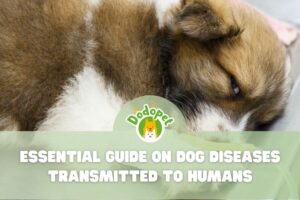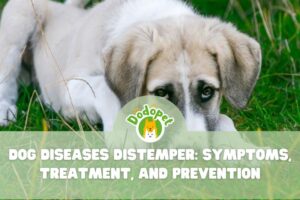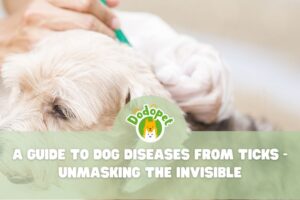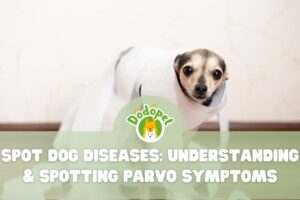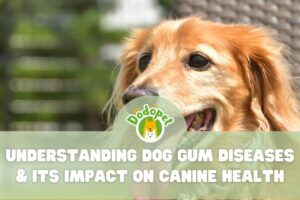Dogs are beloved companions and members of our families. We want to ensure their health and happiness, but sometimes we may overlook certain diseases and symptoms that can affect them. In this article, we will explore some commonly ignored dog diseases and symptoms, shedding light on the importance of early detection and treatment.
The Importance of Regular Veterinary Check-ups
Regular veterinary check-ups are crucial for the health and well-being of your pets. Just like humans, animals require preventive healthcare to catch and address potential issues before they become serious problems. Here are some reasons why regular veterinary check-ups are important:
- Early Disease Detection: Regular check-ups allow veterinarians to detect dog diseases and symptoms or health issues in their early stages. Many illnesses are easier and less expensive to treat when caught early.
- Vaccinations: Vaccinations are a critical part of preventive healthcare. Regular check-ups ensure that your pet receives the necessary vaccinations to protect them from potentially deadly diseases.
- Parasite Control: Fleas, ticks, and internal parasites can be harmful to your pet’s health. Veterinarians can provide guidance on parasite control and prescribe preventive medications.
- Dental Care: Dental health is often overlooked but is essential for your pet’s overall well-being. Regular check-ups can address dental issues and recommend dental care routines.
- Behavioral Issues: If your pet is displaying unusual behavior, a vet can help determine if there is an underlying medical issue contributing to the behavior or provide guidance on addressing behavioral problems.
- Senior Care: As pets age, they require more frequent check-ups to monitor for age-related conditions like arthritis, diabetes, or kidney disease. Catching these issues early can improve your pet’s quality of life.
- Weight Management: Obesity is a common problem in pets, and it can lead to various health issues. Your vet can provide guidance on maintaining a healthy weight for your pet.
- Allergies and Skin Conditions: Pets can suffer from allergies and skin conditions that require medical attention. Regular check-ups can help identify and manage these issues.
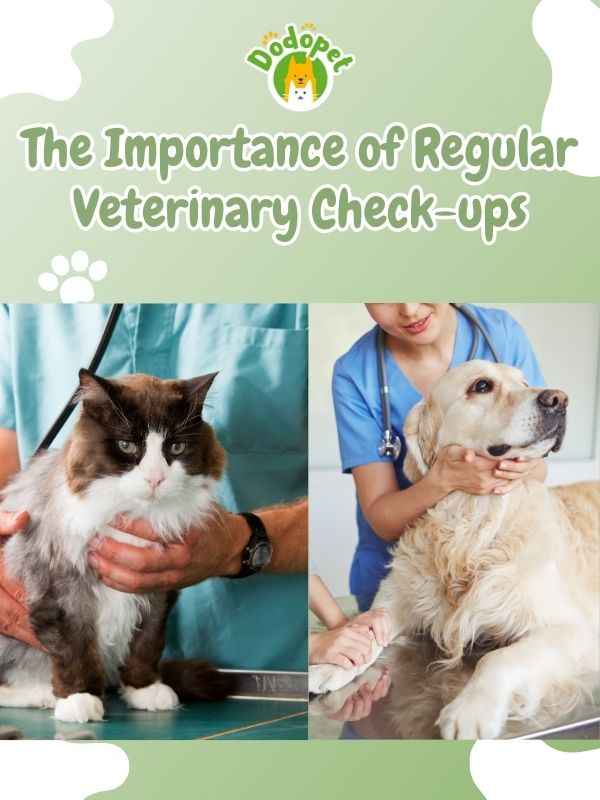
The Importance of Regular Veterinary Check-ups
Dog Dental Diseases and Symptoms
Dental disease is a common and often overlooked health issue in dogs. It can have a significant impact on your dog’s overall health and well-being. Here are common types of Dental Disease that dog owners should know:
- Gingivitis: Gingivitis is an inflammation of the gums and is often the initial stage of dental disease. It can cause redness, swelling, and bleeding of the gums.
- Periodontitis: If left untreated, gingivitis can progress to periodontitis, which involves the destruction of the tooth’s supporting structures. This can lead to tooth mobility, abscesses, and even tooth loss.
- Plaque and Tartar: Plaque is a soft, sticky film of bacteria that forms on teeth. Over time, it hardens into tartar (also known as calculus), which cannot be removed by brushing alone and requires professional cleaning by a veterinarian.
Symptoms of Dental Disease
- Bad breath (halitosis)
- Drooling
- Difficulty eating or chewing
- Pawing at the mouth
- Bleeding or inflamed gums
- Loose or missing teeth
- Changes in behavior (e.g., irritability or reduced playfulness)
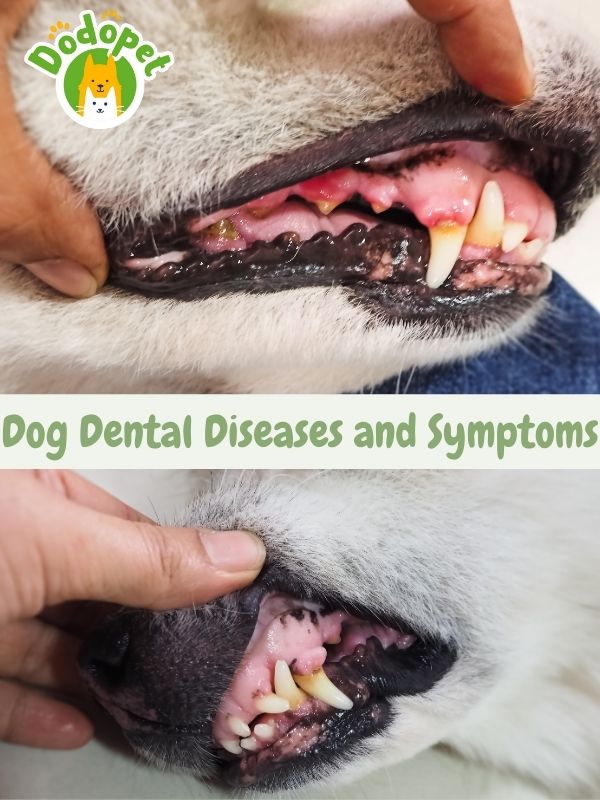
Dog Dental Diseases and Symptoms
How to Prevent Dental Disease in Dogs
Preventing dental disease in dogs requires a combination of home care and regular veterinary check-ups. Here are some effective ways to prevent dental disease in your canine companion:
- Regular Dental Check-ups: Schedule routine dental check-ups with your veterinarian. They can assess your dog’s oral health and recommend necessary treatments, including professional dental cleanings.
- Brush Your Dog’s Teeth: Brushing your dog’s teeth is one of the most effective ways to prevent dental disease. Use a dog-specific toothbrush and toothpaste. Start slowly to get your dog accustomed to the process, and aim to brush their teeth at least 2-3 times a week. Consistency is key.
- Dental Chews and Toys: Provide dental chews and toys designed to promote oral health. Chewing on these items can help remove plaque and tartar from your dog’s teeth. Look for products with the Veterinary Oral Health Council (VOHC) seal of approval, indicating they are effective at reducing plaque and tartar.
- Dental Diets: Some pet food brands offer special dental diets designed to help reduce plaque and tartar buildup. These diets often have a unique texture or formulation that promotes chewing and teeth cleaning.
- Oral Rinses and Gels: Consider using canine-specific oral rinses and gels that can help reduce bacteria in your dog’s mouth and promote oral health. Consult your vet for recommendations.
- Monitor Your Dog’s Dental Health: Regularly inspect your dog’s mouth for signs of dental disease, such as bad breath, inflamed gums, loose or missing teeth, or changes in eating habits. If you notice any of these signs, consult your veterinarian promptly.
Dog Allergies Diseases and Symptoms
Allergies in dogs are relatively common and can cause a range of symptoms and discomfort. Just like humans, dogs can be allergic to various substances, and these allergies can manifest in different ways. The symptoms of allergies in dogs can vary depending on the type of allergy and the individual dog. Common signs include:
- Itching: This is often the most prominent symptom, and dogs may scratch, lick, or chew their skin excessively.
- Skin Infections: Continuous scratching can lead to open sores, hot spots, and bacterial or yeast infections of the skin.
- Ear Infections: Dogs with allergies may develop recurring ear infections, which can cause head shaking and discomfort.
- Digestive Issues: Food allergies can result in diarrhea, vomiting, and gastrointestinal discomfort.
- Respiratory Symptoms: Environmental allergies can sometimes lead to sneezing, coughing, and watery eyes.
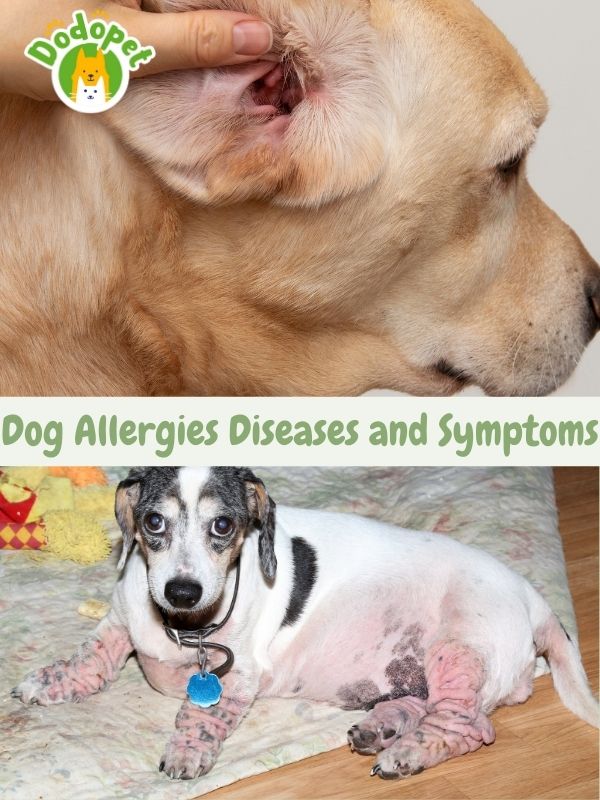
Dog Allergies Diseases and Symptoms
How to Manage Allergies in Dogs
Managing allergies in dogs involves a combination of strategies to alleviate symptoms, identify and avoid triggers, and work closely with your veterinarian. Here’s a step-by-step guide on how to manage allergies in dogs:
- Consult Your Veterinarian:
- If you suspect your dog has allergies or if they are displaying allergy-related symptoms, such as itching, skin issues, or digestive problems, the first step is to schedule a veterinary appointment.
- Your vet will conduct a physical examination, ask about your dog’s medical history, and may recommend diagnostic tests to determine the type of allergy and its triggers.
- Identify Allergen Triggers:
- Allergy testing, such as skin tests or blood tests, can help identify specific allergens causing your dog’s symptoms, whether they are environmental allergens, food allergens, or both.
- Identifying the specific allergens is crucial for effective management.
- Allergen Avoidance:
- Once you know the allergen triggers, take steps to minimize your dog’s exposure to them.
- For environmental allergens, consider these measures:
- Keep your dog indoors during peak allergy seasons, when pollen counts are high.
- Use air purifiers or HEPA filters to reduce airborne allergens.
- Regularly clean your home, including vacuuming and washing bedding.
- Avoid walks in areas with tall grass or weeds.
- For food allergies, your vet may recommend a hypoallergenic diet that excludes common allergenic ingredients. Strictly follow the prescribed diet.
- Medications and Treatment:
- Your vet may prescribe medications to manage your dog’s allergy symptoms. These may include:
- Antihistamines to reduce itching and inflammation.
- Corticosteroids to control severe inflammation and itching.
- Immunosuppressive drugs in cases of severe allergies.
- Always follow your vet’s dosing instructions and report any side effects.
- Your vet may prescribe medications to manage your dog’s allergy symptoms. These may include:
- Immunotherapy (Allergy Shots)
- In some cases, your vet may recommend allergen-specific immunotherapy (allergy shots). This involves gradually exposing your dog to small amounts of the allergen to build tolerance over time.
- Allergy shots are a long-term treatment option and require regular administration.
Dog Arthritis Diseases and Symptoms
Arthritis in dogs, also known as osteoarthritis or degenerative joint disease, is a common and painful condition that affects the joints. It can occur in dogs of all ages and breeds but is more commonly seen in older dogs. Arthritis develops when the protective cartilage that cushions the joints wears down over time, leading to inflammation, pain, and reduced mobility.
Dog Arthritis Symptoms
Dog Arthritis Diseases and Symptoms can vary in severity and may include:
- Limping or Favoring a Leg: Dogs with arthritis may limp or favor one or more legs, especially after periods of rest.
- Stiffness: Arthritic dogs often show stiffness, particularly when getting up after lying down for a while.
- Reduced Activity: A decrease in activity or reluctance to play, walk, or climb stairs can be a sign of joint pain.
- Swelling and Heat: Affected joints may appear swollen, warm to the touch, or painful when touched.
- Licking or Chewing: Dogs may lick or chew at their sore joints in an attempt to relieve pain.
- Changes in Behavior: Pain can lead to changes in behavior, such as irritability or aggression.
- Loss of Muscle Mass: Over time, muscle atrophy may occur in the affected limb due to reduced use.
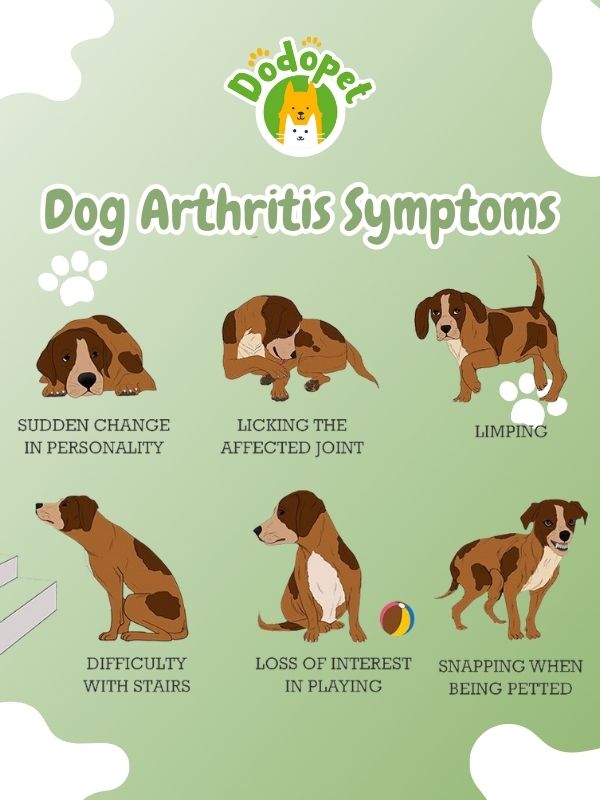
Dog Arthritis Diseases and Symptoms
How to Manage Arthritis in Dogs
Managing arthritis in dogs involves a multifaceted approach that aims to alleviate pain, improve joint function, and enhance your dog’s overall quality of life. Here’s a comprehensive guide on how to manage arthritis in dogs:
- Consult with a Veterinarian:
- If you suspect your dog has arthritis or notice any signs of joint pain, the first step is to schedule a veterinary appointment. Your veterinarian will provide a proper diagnosis and recommend a tailored treatment plan.
- Medications:
- Your veterinarian may prescribe medications to manage your dog’s arthritis pain and inflammation. Common medications include:
- Non-Steroidal Anti-Inflammatory Drugs (NSAIDs): These drugs, such as carprofen or meloxicam, reduce pain and inflammation. Use them only under veterinary guidance and monitoring, as they can have side effects.
- Pain Medications: Other pain-relief medications may be prescribed, such as tramadol or gabapentin.
- Your veterinarian may prescribe medications to manage your dog’s arthritis pain and inflammation. Common medications include:
- Weight Management:
- Maintain your dog at a healthy weight. Excess weight puts extra strain on joints, exacerbating arthritis symptoms. Consult your veterinarian for a suitable diet plan and portion control.
- Dietary Supplements:
- Consider joint supplements containing ingredients like glucosamine, chondroitin, and omega-3 fatty acids. These supplements can promote joint health and reduce inflammation. Consult your vet for suitable products and dosages.
- Specialized Diet:
- Ask your veterinarian about prescription diets designed for dogs with joint issues. These diets often include ingredients that support joint health and can be helpful for dogs with arthritis.
- Exercise and Physical Therapy:
- Develop a controlled exercise routine tailored to your dog’s needs. Low-impact activities like swimming or walking on soft surfaces can help maintain muscle strength, flexibility, and joint mobility.
- Consider physical therapy sessions provided by a veterinary specialist. These sessions can include exercises and techniques to improve joint function.
Dog Heartworm Diseases and Symptoms
Heartworm disease is a serious and potentially fatal condition caused by parasitic worms that live in the heart and blood vessels of infected dogs. It is transmitted through mosquito bites and can be easily prevented with regular medication. However, many pet owners neglect to administer preventive treatments, putting their dogs at risk.
Dog Heartworm Symptoms
Some of its common symptoms are:
- Heartworm disease is often referred to as a “silent killer” because early-stage infections may not show noticeable symptoms.
- As the disease progresses, dogs may exhibit symptoms such as coughing, lethargy, exercise intolerance, difficulty breathing, weight loss, and a swollen abdomen.
- In severe cases, dogs can develop heart failure, and the disease can be fatal.
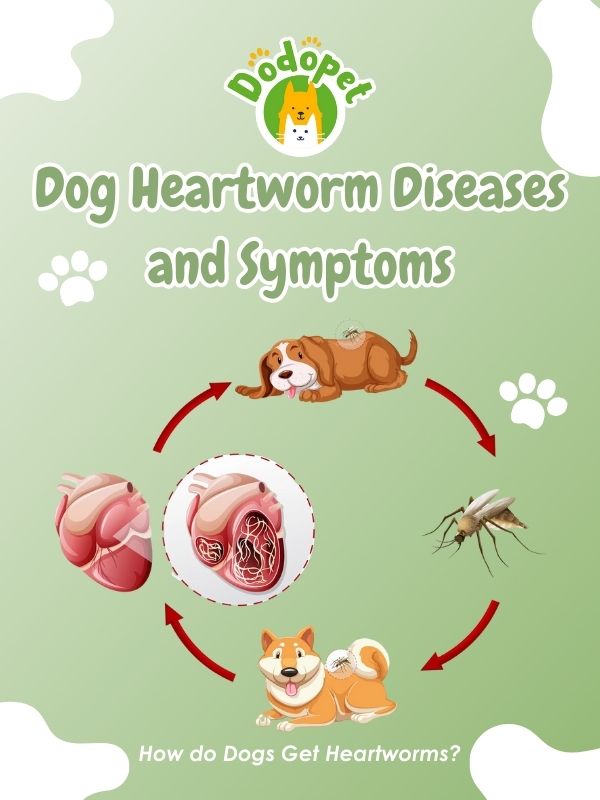
Dog Heartworm Diseases and Symptoms
How to Prevent Heartworm Disease in Dogs
Preventing heartworm disease in dogs is essential for their health and well-being. Fortunately, it’s relatively straightforward with proper preventative measures. Here’s a guide on how to prevent heartworm disease in dogs:
- Consult Your Veterinarian:
- Schedule a visit to your veterinarian to discuss heartworm prevention options and determine the best plan for your dog based on their age, health status, and lifestyle.
- Choose a Heartworm Preventative Medication:
- Your veterinarian will prescribe a heartworm preventative medication that suits your dog’s needs. These medications are available in various forms, including oral tablets, chewables, topicals, and injectables.
- Common heartworm preventatives include:
- Monthly Oral Medications: These are given orally and are highly effective. Examples include Heartgard, Sentinel, and Trifexis.
- Topical Solutions: Applied to the skin, such as Revolution.
- Injectable Prevention: A veterinarian-administered injection that provides protection for several months, such as ProHeart 6 or ProHeart 12.
- Follow your veterinarian’s recommendations for the type and dosage of medication.
- Administer Medication Regularly:
- Administer the heartworm preventative medication exactly as prescribed by your veterinarian. Consistency is crucial to ensure your dog remains protected.
- Set up a reminder system to help you remember when to give the medication.
- Annual Heartworm Testing:
- Even if your dog is on a heartworm prevention program, it’s essential to have them tested annually for heartworm disease. Testing can detect infections that may have occurred despite preventive measures.
- Some veterinarians recommend testing before starting a prevention program to ensure your dog is not already infected.
- Avoid Missed Doses:
- If you miss a dose of heartworm prevention, contact your veterinarian for guidance. Depending on the medication and the length of time missed, your dog may need to be retested for heartworms before continuing prevention.
- Reduce Mosquito Exposure:
- Heartworms are transmitted by mosquitoes. Minimize your dog’s exposure to mosquitoes by:
- Using mosquito repellents formulated for dogs (consult your veterinarian for recommendations).
- Avoiding outdoor activities during peak mosquito activity, typically during dawn and dusk.
- Installing mosquito screens on windows and doors in your home.
- Heartworms are transmitted by mosquitoes. Minimize your dog’s exposure to mosquitoes by:
Dog Obesity Diseases and Symptoms
Dog Obesity Diseases and Symptom is a common and concerning health issue. It occurs when a dog carries an excessive amount of body fat, which can lead to various health problems and a reduced quality of life. Understanding the causes, consequences, and prevention of obesity is essential for responsible pet ownership.
Dog Obesity Symptoms
Identifying the symptoms of obesity in dogs is crucial for early intervention and prevention of associated health problems. Here are common signs and symptoms of obesity in dogs:
- Excessive Weight: The most obvious sign is that your dog is carrying excess weight. You should not be able to see or feel their ribs easily, and they may have a round or barrel-like appearance.
- Lack of a Visible Waist: A healthy dog should have a noticeable waist when viewed from above. An obese dog may appear square or oval-shaped from this perspective.
- Difficulty Walking and Moving: Obesity puts additional stress on a dog’s joints and can lead to decreased mobility. Your dog may struggle to move, climb stairs, or jump onto furniture.
- Shortness of Breath: Overweight dogs may exhibit rapid breathing or panting, even with minimal physical activity. This can be due to the extra effort required to move their heavier body.
- Excessive Panting: Obese dogs may pant excessively, especially in warm weather, as they have a harder time regulating their body temperature.
- Lethargy: Obesity can lead to reduced energy levels and overall lethargy. Your dog may be less interested in play or exercise.
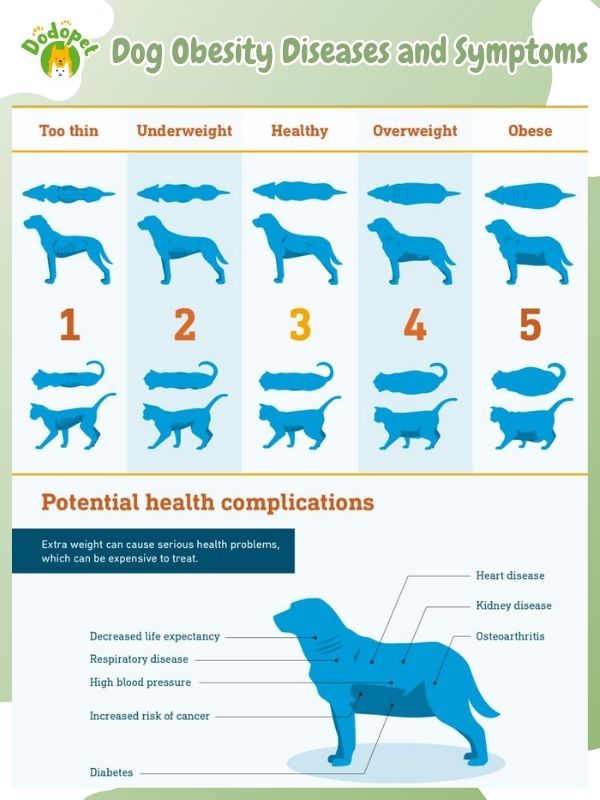
Dog Obesity Diseases and Symptoms
Dog Obesity Health consequences
Obesity can have severe health consequences for dogs, including:
- Joint Problems
- Respiratory Issues
- Diabetes
- Cardiovascular Problems
- Decreased Lifespan
- Reduced Quality of Life
How to Prevent Obesity in Dogs
Preventing obesity in dogs requires a proactive approach to their diet, exercise, and overall lifestyle. Here are several strategies to help prevent obesity in your canine companion:
- Consult Your Veterinarian:
- Start by discussing your dog’s diet and exercise needs with your veterinarian. They can provide recommendations tailored to your dog’s breed, age, and health status.
- Measure Food Portions:
- Use a measuring cup to ensure accurate food portions for each meal. Avoid free-feeding, where food is left out all day, as it can lead to overeating.
- Select High-Quality Dog Food:
- Choose a high-quality dog food with appropriate nutritional content for your dog’s age, size, and activity level. Look for products that list a specific meat source as the first ingredient.
- Avoid Table Scraps:
- Refrain from feeding your dog from the table, as human food can be high in calories and may not provide the necessary nutrients. Encourage family members and guests to do the same.
- Limit Treats and Use Healthy Options:
- Limit the number of treats you give your dog, as they can add extra calories. Choose low-calorie, healthy treats or use pieces of fruits and vegetables as treats. Be mindful of portion sizes.
- Regular Exercise:
- Ensure your dog gets regular exercise appropriate for their age and breed. Daily walks, playtime, and interactive toys can help burn calories and maintain a healthy weight.
Conclusion
By being aware of these commonly ignored dog diseases and symptoms, you can take proactive steps to ensure the health and well-being of your furry friend. Regular veterinary check-ups, proper dental care, allergy management, arthritis treatment, heartworm prevention, and weight management are all essential aspects of responsible pet ownership. Remember, early detection and treatment are key to keeping your dog happy and healthy for years to come.

